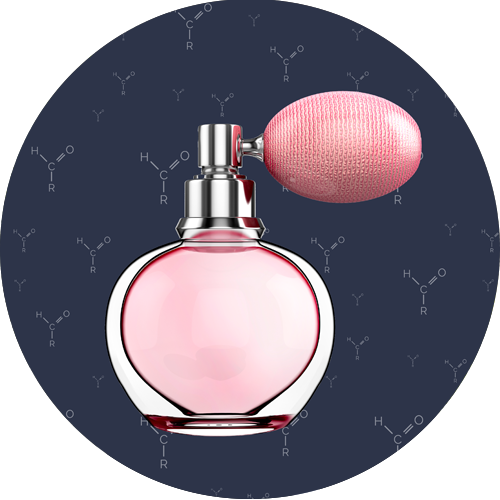To talk about aldehydes, the first thing is to define them chemically: they are organic compounds in which a carbon atom shares a double bond with an oxygen atom, a single bond with a hydrogen atom, and a single bond with another atom or group of atoms.
Aldehydes are primarily used for the manufacture of resins, plastics, solvents, paints, perfumes, and essences.
The term “aldehyde” is a contraction of the words “alcohol” and “dehydrogenatus” (dehydrogenated alcohol), originally coined by the chemist Auguste Georges Darzens. This French organic chemist, born in Russia, first discovered aldehydes in 1903 when he synthesized C12 MNA. Subsequently, Blaise isolated the aldehydes C8, C9, C10, C11, and C12 Lauric.
At first, the perfume industry ignored aldehydes, as it was considered that the new scents were not potent enough on their own. But the function of Darzens’ aldehydes was revealed when it was discovered that the chemical compound could enhance the other aromatic ingredients of a perfume. When used subtly and skillfully dosed, aldehyde molecules have the ability to reveal and enhance a fragrance.
Aldehydes are present in many organic materials such as citronella, vanilla, and orange peel. The most characteristic is the coriander leaf. Scientists can also create these compounds synthetically to use them as ingredients for perfumes, personal care products, air fresheners, and laundry detergents, as they enhance the aromatic harmony of an olfactory experience. They are often associated with floral notes and reveal the nuances of each aroma to achieve a deeper, fuller, and more elevated fragrance.
Aldehydes in Fine Perfumery: The History of Chanel N°5
In 1921, Russian perfumer Ernest Beaux created Chanel N°5 at the request of Coco Chanel, who asked him for a creation with the finest qualities of rose, jasmine, and ylang-ylang. In the design of the perfume, aldehydes were to represent a small dose that would provide the enfleurage character lost with modern extraction methods and thus enhance its performance on the skin.
Legend has it that, while preparing new samples of this perfume, aldehydes were incorporated by mistake in a dilution ten times greater than Beaux had originally indicated. The result was a surprise and a great satisfaction for the perfumer: the prominence of the aldehydes (C8, C9, C10, and C12 MNA) in the perfume was enhanced, and their strong presence in the floral accord led to, for the first time in history, one of the main notes of a perfume not being based on a natural scent, making it an innovative and revolutionary perfume for its time.
Today, aldehydes are a basic ingredient in perfumes. For example, Melonal has a very open, fresh, and ozonic start, which is very important for perfumes, mainly men’s ones.
Perfume houses are constantly creating new aldehyde molecules that can enhance and reveal fragrances and top notes in new releases, which are currently concentrated in the “muguet” (lily of the valley) flower family.
You can also find us on






